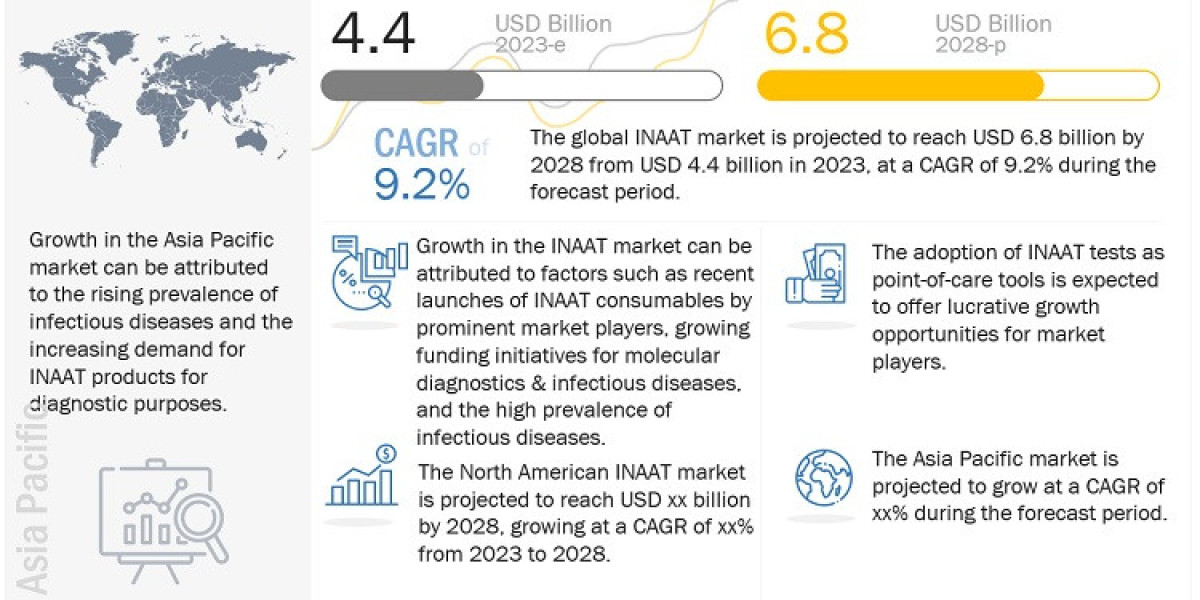The report "Isothermal Nucleic Acid Amplification Technology Market by Product (Assay, System), Technology (LAMP, SDA, NASBA, NEAR, HDA), Application (Diagnostics (Influenza, Hepatitis, CT/NG, COVID-19), blood screening), End User - Global Forecast to 2028", is projected to reach USD 6.8 billion by 2028 from USD 4.4 billion in 2023, at a CAGR of 9.2% during the forecast period.
Download PDF Brochure: - https://www.marketsandmarkets.com/pdfdownloadNew.asp?id=839
The isothermal nucleic acid amplification technology market is expected to grow at a CAGR of 9.2% during the forecast period. The growth of the market is attributed the growing funding initiatives for molecular diagnostics & infectious diseases, and recent launches of INAAT consumables by prominent market players. However, the unfavorable reimbursement scenario for in vitro diagnostic tests is a major factor restraining market growth.
Assay, kits and reagents segment accounted for the largest share of the INAAT market
Based on the product, the INAAT market is segmented into assay, kits, and reagents, and systems. The assay, kits, and reagents segment accounted for the largest share in 2022, which is attributed to increasing demand of infectious disease diagnostic tests, infectious diseases-the continuous launch of newer, faster, and more reliable POC products and extensive use of INAAT products.
LAMP segment accounted for the largest share of the INAAT market
Based on technology, the isothermal nucleic acid amplification technology market is segmented into loop-mediated isothermal amplification (LAMP), transcription-mediated amplification (TMA), strand displacement amplification (SDA), nicking enzyme amplification reaction (NEAR), single-primer isothermal amplification (SPIA), and other technologies. The loop-mediated isothermal amplification (LAMP) segment dominated the market in 2022. The largest share of this segment is attributed to the prominent players in the market offering LAMP kits and rising of LAMP kits in infectious diseases diagnostics.
Infectious disease diagnosis segment accounted for the largest application segment of the market
Based on application, the INAAT market is segmented into infectious disease diagnosis, blood screening, and other applications. The disease diagnosis segment is expected to dominate the market in 2022. Various factors drive the growth of the segment are launch of INAAT covid-19 kits and extensive use of INAAT in diagnosis of Hepatitis and HIV.
Hospital segment accounted for the largest share of the global INAAT market
Based on the end user, the market is divided into hospitals, reference laboratories, academic and research institutes, and other end users. The hospital segment is expected to account for the largest share of the INAAT market in 2022. This is owing to high demand for fast test and kits, increase in patient population, extensive use of moleucular diagnostic kits and need for early doagnostic solutions.
North America accounted for the largest share of the market
North America is expected to account for the largest share of the global INAAT market, followed by Europe in 2022. The largest share of the North American market is attributed to the presence of a leading market players, growing burden of infectious diseases and availability of R&D funding for molecular diagnostics.
Request for Sample Pages: - https://www.marketsandmarkets.com/requestsampleNew.asp?id=839
The prominent players operating in INAAT market are Grifols, S.A. (Spain), Hologic, Inc. (US), Abbott Laboratories (US), Becton, Dickinson and Company (US), Meridian Bioscience (US), Eiken Chemical Co., Ltd. (Japan), bioMérieux SA (France), Tecan Trading AG (Switzerland), New England Biolabs (US), QIAGEN N.V. (Germany), DiaSorin S.p.A. (Italy), General Electric (US), OptiGene Limited (UK), Quidel Corporation (US), Thermo Fisher Scientific (US), Genomtec (Poland), Mast Group Ltd. (UK), Ustar Biotechnologies (China), Jena Bioscience GmbH (Germany), Atila BioSystems (US), TwistDx Limited (UK), LGC Limited (UK), Life Sciences Advanced Technologies (US), GenoSensor Corporation (US), and PCR Biosystems (UK).



